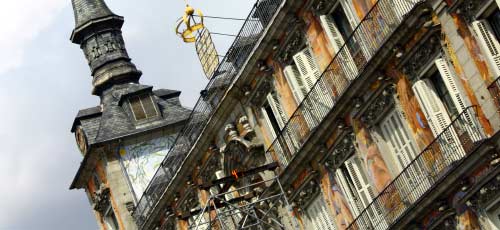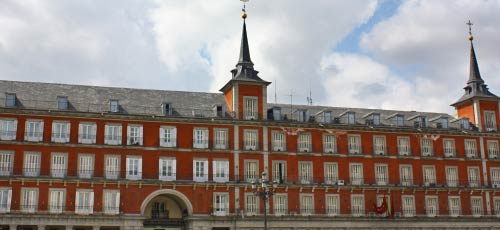Madrid-Tourist.com
The best independent guide to Madrid
Madrid-Tourist.com
The best independent guide to Madrid
Plaza Mayor, Madrid Guide
Plaza Mayor is the old historic centre of Madrid and unlike the modern centre Puerta del Sol still retains its charm and appeal. As the Plaza Mayor was original designed in 1617 during the Hapsburg era and the square has played a central role in many both joyful and traumatic events which have shaped Spain. Unlike many other capital cities the central square of the Plaza Mayor is surrounded by private residence and not government offices or state rooms. Today the three levels of apartments are still in the possession of private residence, who possible own the most exclusive address in Madrid.
The only exceptions are the painted building to the north of the square, which is used as an exclusive venue for weddings and other functions and the building directly opposite on the south side which was owned by the council of Madrid but soon to be converted into a hotel. These private residences used to earn the owners of the rooms a heft wage as the balconies which over look the square used to be rented out to the aristocrats during major public events.

This tearing system could be counted as one of the earliest examples of a modern day stadium with the entire Plaza Mayor accommodating up to 50,000 spectators. The lower and working classes where held back by large wooden fences which ran the perimeter of the square, while the high level rooms were rented for the modern day equivalent of thousands of dollars.
It is difficult to comprehend the Plaza Mayor in the present day form as an area for brutal contests between matadors pitted against raging bulls but the square was the prime venue for this supposed sport until Madrid’s bull ring was constructed in 1830. The statue of Philip III was only moved into Plaza Mayor under the direction of Queen Elisabeth II in 1848 after the change in role for the square.

During the early years of the Franco dictatorship many objects relating to the old regime were smashed and damaged including the Statue of Philip III. When the Statue of Philip III was toppled from its base and smashed on the stone ground hundreds of small bird bones fell out causing the conspirators to believe they had let out an evil spirit or cursed themselves with bad luck. It was later discovered that the birds had entered the statue via a small hole but due to the angles had been unable to escape so had died of starvation, luckily for the birds today the hole has been sealed up.
The main square of Plaza Mayor was constructed on land that was far from level and there is a gentle drop of the land towards the south of the square. Outside the Plaza Mayor there are substantial walls built from massive stones which support the weight of the inner square. Into these walls there are small cellars with arching stone roofs that support the weight of the Plaza, many of these old, dimly lit cellars have been converted into traditional bars and restaurants.
Madrid has always had issue concerning the supply and demand for water especially during the intense summer months. One solution was to construct massive water tanks below the Plaza Mayor which could be drained during periods of drought or relied upon in the event of a major fire. Sadly the fire protection proved to be ineffectual and the buildings surrounding the plaza bunt to the ground of three separate occasions with the longest fire raging for 5 days. The original construction martial of the apartments surrounding the plaza did not assist matters as they were solely built from wood.
The buildings which presently surround the Plaza Mayor originate from 1790 after the last major fire to destroy the square, the architect who designed the area was Juan de Villanueva. There is a total of 237 balconies facing the central square which covers an area of 129 by 94 metres. The 9 entrances of the present day layout correspond to the previous reincarnations of the main entrances and streets. The ancient name of the Plaza Mayor was the Plaza del Arrabal which prior to the construction of the square was a mass of narrow streets with no distinct plan. The Plaza Mayor was renamed on numerous occasions the Plaza de la Constitución (Square of the Constitution) between 1812 and 1935 but the name was reverted to Mayor at the end of the Spanish Civil War.
The Plaza Mayor was the centre of torture and executions during the Spanish Inquisition with hundreds of people condemned to death accused of being heretics. The square was the location for the autos-da-fé, long religious ceremonies ending in the trails of the heretics, which commonly ended in executions. During the reign of Philip V there were 125 autos-da-fé performed in Madrid and the majority held in Plaza Mayor on public holidays. An estimate of the total number of religious trails during the height of the Spanish inquisition (1540–1699) tops 50,000 with 1-3% of people found guilty and put to death. Not the plaza Mayo greatest moment.
Madrid Holiday Guide
|
| ||||||
|
| ||||||
|
| ||||||
|
| ||||||
|
|









